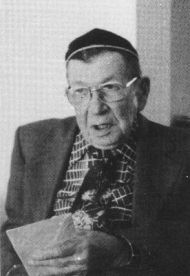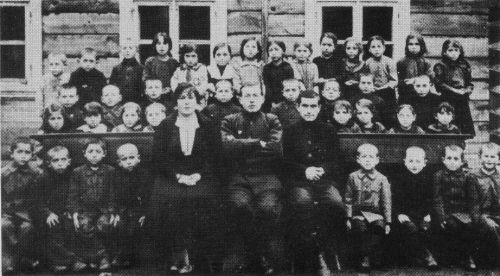
|

|
|
|
[Page 1]
This project is dedicated to the late Philip Sidransky without whose gentle guidance it would not have been possible. Mr. Sidransky, born in Dubrowa in 1894, is pictured below with his pupils in the Dubrowa school c. 1917. Shortly afterward he immigrated to Canada. The picture at the right shows Mr. Sidransky at his home in Miami Beach, December 1980, about a year before his death.
The booklet also is dedicated to the future generation, my children Andrea, Danny and Teddy, who might benefit from it for, as an old Hebrew saying states, “Before you know who you are and where you are going, you must know from where you come.”
|
|
[Page 2]
In 1977, inspired by the popular television program about black history, Roots, it became fashionable for Jews to explore their own origins. My own quest began with the construction of a family tree with special attention being paid to those individuals who had immigrated to this country, and their predecessors. Information accumulated along all family branches but my major interest soon focused on my paternal grandparents and their Polish-Russian shtetl Dubrowa, from where they had emigrated in the 1890s.
My grandparents had died years before but a surviving relative, Philip Sidransky, proved to be a good source of material. Mr. Sidransky, living alone in Miami Beach, was in frail health but blessed with a scholarly and organized mind. Indeed, he seems to have been the only Dubrowa emigre to have made any effort to research the town's history .He helped me to fill out some of the twigs on the family tree, but whereas accumulating names from the past is the genealogist's delight, it tends to become a sterile exercise when the names are divorced from the history of their times. Therefore, I began to concentrate increasingly on the story of the town itself.
I began with the usual sources familiar to Jewish genealogists: encyclopedias, the Mormon Church microfilm records, the YIVO library and archives, a classified ad in the Jewish genealogy journal, Toledot. However, Dubrowa was elusive and, at first, other than for several scant references, it seemed almost as if the town had never existed. It soon became apparent that Dubrowa had been too small and insignificant for any great events to have happened there nor did any famous historical personalities emerge from the town.
The Dubrowa landsmanshaftn society was contacted and provided the names to a few surviving immigrants but initial inquiries yielded few replies and little useful information.
After World War II hundreds of landsmanshaftn, first appreciating the magnitude of the catastrophe that had befallen the European Jewish community, wrote memorial books (yiskor bikhers) commemorating their holocaust martyrs and recounting their town's histories. Most of these books were multiauthored and described communities that had been located in Poland between the World Wars. In effect, this was the last great service of the landsmanshaftn organizations which themselves were declining because of aging membership and loss of purpose. If the intent was to pass on the tradition by preserving the memory of their former towns, the result sadly was unrealized since most were written in Yiddish, a language largely unfamiliar to the younger generations.
In the case of Dubrowa, except for a few abortive attempts, no town history had been written. This, then, became my self-appointed mission. My own modest effort at writing a yiskor book, although lacking in the authenticity of a document written by a native, at least would be written in English and therefore might be a useful contribution. After
[Page 4]
more than a year of limited returns from my numerous inquiries and efforts, letters began to arrive from former Dubrowa immigrants. In time, sufficient contacts were made from which to construct a reasonably detailed account of the period between the World Wars. The project's culmination came on January 26, 1982, when during a trip to Israel I had the good fortune to interview the town's last two survivors of the Holocaust period.
Although this account is not proposed as a definitive historical document, sufficient material has accumulated to provide the essence of Dubrowa's past. Its very ordinariness makes Dubrowa's story that of the typical shtetl, a microcosm of the Jewish experience in Poland-Russia.
Author's Note
Spelling variations of place names often confound the unwary student of East European Jewish history and such is the case with Dubrowa. Its name and nationality changed frequently according to shifting political events, at various times the community being under Polish, Lithuanian, Prussian and Russian influence. Out of deference to our ancestors, the immigrants who came to this country early in this century, I have retained the Russian spelling rather than the contemporary Polish version Dabrowa. The Yiddish form, Dombrowa, comes closest to the phonetic pronunciation dom-brava.
Regardless of spelling, Dubrowa was a popular appellation and today there are well over one hundred Polish communities of this name. The name means “oak forest” and it is ironic that the author lives in a New Jersey suburban subdivision also known as Oak Forest! Most other Dubrowas are small villages although one, Dabrowa Gornicza, is a large city in the coal mining region near Cracow.
In the heyday of its Jewish period, Dubrowa was part of the Russian Pale of Settlement and in the political and cultural orbit of its nearest large city, Grodno, about 28 kilometers, to the east. After World War I the area reverted to Polish control but the realignment after World War II shifted the Polish-Russian border to run directly between Dubrowa and Grodno. As a result Dabrowa now is located in the Polish province of Bialystock and is distinguished from the other Dabrowas by the combined designation Dabrowa Bialystocka.
The first mass exodus of Jews from Western Europe to Poland occurred in the 13th and 14th centuries. The Princes of Poland and Lithuania had united forces in 1386 and eagerly sought immigrants to help rebuild their lands recently destroyed by the invading Mongols. In turn, the Jews were anxious to flee the hostile climate of Germany and the massacres of the Middle Ages. Rabbi Moses Isserles in the 16th century explained that it was preferable to live on dry bread and in peace in Poland than to remain in better conditions in more dangerous lands.
The Jews, still suffering from the memories of pogroms in the West, conceived the idea of an enclave or self-contained town in which they could be secure. In this fashion began the small Jewish communal town or shtetl. In some cities the Jews were granted civil and religious rights, in Grodno as early as 1339. As a result the Jewish population in Poland swelled to between 20 and 30 thousand by the end of the 15th century and it has been estimated that during the Middle Ages about 80 percent of all Jews in the world lived in Eastern Europe.
In the early 16th century a wave of colonization began in the dense Nowodworsky Forest along the Biebrzy (Bobr) River west of Grodno. The earliest known settlement was the village of Grodziszczany. Dubrowa was first mentioned as part of a land grant from King Sigismund I to the boyar Kuzmic Horczakowiczowi whose family returned ;ii the area to the king in 1558 in exchange for other property.
Dubrowa was located on a small tributary of the Biebrzy River, the main river running about 5 km to the north and eventually feeding into the Vistula. The region was picturesque and consisted of rich fertile land with dense forests of oak, maple, and sycamore and a view of surrounding green hills.
By 1712 Dubrowa had emerged as the economic center of a cluster of three towns, fifty villages and six large farms and was awarded town rights through the efforts of the Lithuanian Chancellor Antony Tyzenhauza. The early settlers were peasants and artisans many of whom collected honey from the forests. Houses were built according to a uniform plan and the inhabitants were given small parcels of land to encourage them to become involved in crafts and commerce. In 1873 Dubrowa was designated as the county seat of the Grodziensky District.
In the last part of the 18th century Poland was divided and then abolished by its enemies Prussia, Austria and Russia. With the third and last partition in 1795 Dubrowa briefly came under Prussian control. This arrangement was short-lived for in 1807 Napoleon and Czar Alexander signed the Treaty of Tilsit while on a barge in the middle of the Nieman River. This eliminated the Prussian presence and created the Duchy of Warsaw under Russian domination but with certain concessions made to the historic Polish entity. Dubrowa was located in this I Duchy but after Napoleon's defeat, the Congress of Vienna in 1815 again altered the political map. The Duchy became the Kingdom of
[Page 6]
|
|
| Expansion of Russia 1772-1815 | |
Poland (“Congress Poland”) but the Bialystock region which included Dubrowa, officially fell under Russian control. With the Russian administrative system of gubernis “Dubrowa” became part of the Sokolka district of Grodzieflsky (later Grodno) Guberni, the most northwestern of that guberni's four districts.
During this tumultuous period Dubrowa's population grew slowly; in 1799 the town numbered 732 inhabitants and 123 homes, and by 1830 1438 people resided in 207 homes.
It is not my intent to recount in detail the familiar story of the Jews in 19th century Russia. Russia's one million Jews had hailed Alexander I as a liberator when he ascended the throne in 1801. By the time Alexander II was assassinated eighty years later, Jewish fortunes had evolved through several cycles of alternate hope and anguish. Nearly five
[Page 7]
million Jews were herded into a restricted territory, the Pale of Settlement, whose size was gradually diminished even as the population swelled. They were banned from professional life, had their educational opportunities restricted, were banished both from the cities and the land, and were conscripted into the army at an early age for twenty- five-year tours of duty. The net result of this disastrous period was that most Jews lived on the edge of poverty, starvation and despair. When Alexander III initiated a policy of one-third conversion, one-third emigration and one-third starvation to deal with “the Jewish question,” the great wave of Jewish exodus out of Russia began in earnest.
|
|
| The vicinity of Dubrowa (drawn by Abraham K. Gusewich In 1982) | |
|
|
JewishGen, Inc. makes no representations regarding the accuracy of
the translation. The reader may wish to refer to the original material
for verification.
JewishGen is not responsible for inaccuracies or omissions in the original work and cannot rewrite or edit the text to correct inaccuracies and/or omissions.
Our mission is to produce a translation of the original work and we cannot verify the accuracy of statements or alter facts cited.
 Dąbrowa Białostocka, Poland
Dąbrowa Białostocka, Poland
 Yizkor Book Project
Yizkor Book Project
 JewishGen Home Page
JewishGen Home Page
Copyright © 1999-2024 by JewishGen, Inc.
Updated 16 Jan 2010 by LA